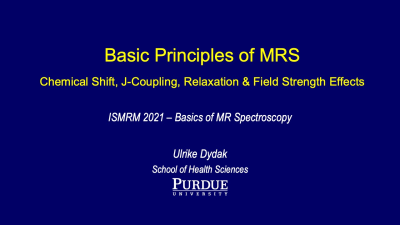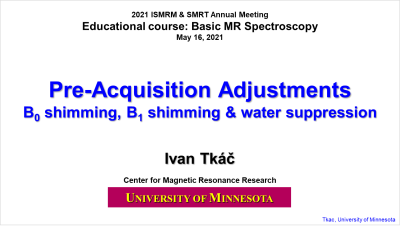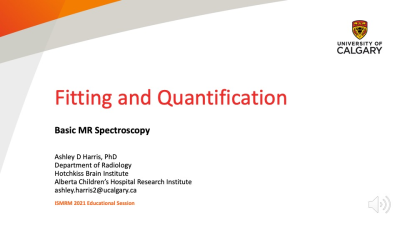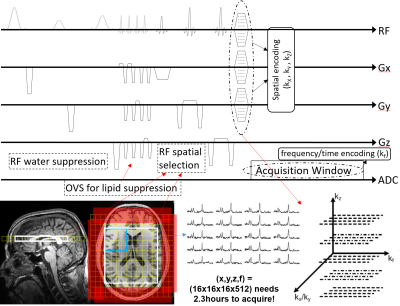Weekend Course
Basic MR Spectroscopy
ISMRM & SMRT Annual Meeting • 15-20 May 2021

| Concurrent 2 | 13:00 - 13:45 | Moderators: Erin MacMillan & Francesca Branzoli |
 |
Basic Principles of MRS (Chemical Shift, J-Coupling, Relaxation & Field Strength Effects)
Ulrike Dydak
This lecture introduces the basic principles of MR Spectroscopy. Concepts such as chemical shift, J-coupling, the ppm-unit of the frequency axis, basic acquisition requirements and spectral resolution are explained. Furthermore, the effects of relaxation and field strength on the MR spectrum are discussed.
|
|
| Acquisition Methods (PRESS, STEAM, semi-LASER, MEGA-PRESS, MRSI)
Ralph Noeske
This lecture will cover the most common MRS volume localization techniques PRESS, STEAM and semi-LASER that are based on overlapping slices for improved volume selection. The design of techniques for unwanted signal suppression like an appropriate crusher scheme and phase cycling as well as how to address the chemical shift displacement error are explained. The principle of the MEGA extension of PRESS for selective metabolite editing will be shown. Following consensus recommendations, the implementation of a standardized semi-LASER sequence addressing the previously discussed requirements is demonstrated.
|
||
 |
Pre-Acquisition Ajustments (B0 Shimming, B1 Shimming & Water Suppression)
Ivan Tkac
Pre-acquisition adjustments in 1H MRS are essential precondition that directly affects the quality of acquired spectra, which is the key factor for reliable metabolite quantification. B1 shimming is used only for ultra-high magnetic fields (7T and above) to maximize the peak B1+ in the region of interest. B0 shimming is the adjustment of magnetic field spatial homogeneity, which is the key factor affecting the spectral resolution. Efficient water suppression (WS) is very important because the strong residual water signal may interfere with metabolite quantification. Two WS techniques are discussed: VAPOR and metabolite cycling.
|
|
 |
Fitting & Quantification
Ashley Harris
This educational talk overviews some recommended preprocessing steps and then examines fitting and quantification for MR spectroscopy data. Preprocessing (or processing) aims to optimize the quality of acquired data. The next step is “fitting”. As we know the area under a peak is proportional to its concentration, fitting consists of modeling each peak in order to determine its area as well as the area of the reference metabolite or water. Once we have the data fit, quantification can be performed, typically using water as a reference and in the most complete approach accounts for relaxation in all tissue components.
|
|
| Quality Assessment for 1H MR spectroscopy of the brain: Artifacts, Solutions, and Criteria
Yan Li
The accuracy of measuring brain metabolite levels highly relies on spectral quality. Assurance of quality control is required for translating proton MR spectroscopy (1H MRS) technologies into clinical studies. This lecture focuses on the basics of MRS methodology, artifacts with their causes and possible solutions, and quality control for single and multi-voxel 1H MRS.
|
||
 |
Field Dependence: Gains & Challenges of Ultra-High-Field MRS
Vincent Boer
There is a drive towards increasing magnetic field strength for MRI. In this lecture we cover the main gains at ultra-high field, specifically for MR spectroscopy. Also, the major drawbacks are discussed, including changes in relaxation time and difficulties with B0/B1 field homogeneity.
|
|
 |
MRSI Readout Strategies (Echo-Planar [EPSI] & Spiral-MRSI)
Borjan Gagoski
This talk covers the basics of MRSI readout strategies, by first introducing the conventional, phase-encoded scheme, which requires long acquisition times to encode the (kx,ky,kz,kf) space. It then introduces the idea of simultaneous spectral-spatial encoding within the same TR, made possible by the fact that the brain metabolites span only limited spectral bandwidth (e.g. ~1000Hz @3T). It continues with a description of two classical readout schemes that accelerate PE MRSI using this concept: 1. echo-planar and 2. spiral spectroscopic imaging. Lastly it shows how these two can be further accelerated using standard parallel imaging reconstruction methods like SENSE and/or GRAPPA.
|
The International Society for Magnetic Resonance in Medicine is accredited by the Accreditation Council for Continuing Medical Education to provide continuing medical education for physicians.